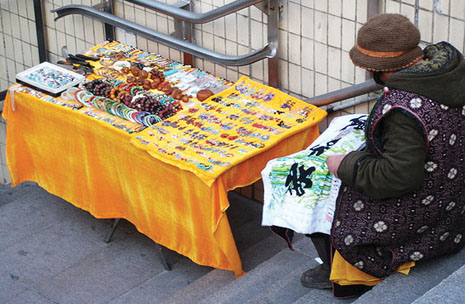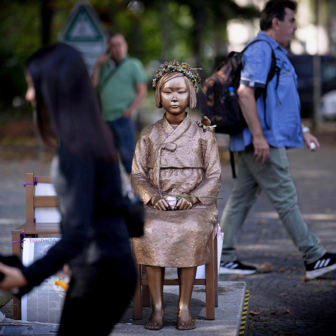THE Tibetan street pedlars are back. They were expelled from Beijing for the course of the eighteenth party congress in November, or went into hiding, but they cannot have gone very far. Soon after the end of proceedings they were back on the steps of Dongsishitiao subway station hawking their factory-produced “handicrafts”: beads, combs, bronze ware. They wear thick skirts and boots that give them a slightly exotic look.
In a sphere well removed from theirs, art collectors gathered at the end of November for the inaugural Poly International Auctions event in Hong Kong. The top-selling piece was a scroll painting, Tibetan Women with Dogs, by Zhang Daqian (1899–1983), one of the best-known painters of twentieth-
century China. The title in English does not do justice to the original, which translated literally would read “barbarian women with mastiffs.” The word for barbarian is never used in official language now, but it used to be a common term for non-Chinese, including the Western “foreign devils.”
The painting sold for the equivalent of nearly A$6 million, close to seven times the anticipated top bid. Zhang, a prolific artist of great technical skill, is famous for his forgeries of old masters. The question with this painting, however, is whether this time he might be the victim rather than the perpetrator of a forgery.
Art auctions in China are a major means of money laundering by officials. A journalist for the Global Times has described how it works. The corrupt official, desiring to create a legitimate-seeming paper trail for money being offered as a bribe, puts up for auction a forged painting that has been given to him by the client. At the auction, the client and a partner bid the price up to the desired level of the bribe. Having won the bid, the client buys the painting, and the official pockets the proceeds. For a very high bid to be credible, the painting needs to be the work (putatively) of someone of Zhang Daqian’s status.
This painting’s provenance looks reasonably sound. It is known to have been executed in 1944, when Zhang was living in Chongqing, China’s wartime capital. He had spent much of the two preceding years in the ancient Buddhist caves of Dunhuang, a famed site on the Silk Route, where he was employed in copying murals for the regional satrap. Working alongside him was Sha Bo Tshe Ring, a young Tibetan painter from the Amdo region, in present-day Qinghai province. Other people in Tibetan dress must frequently have crossed Zhang’s path during these years, providing the context and inspiration for his painting. Such details surrounding the history of the piece are reassuring. Its most recent owner was reportedly a well-known collector, Liu Piji.
The reputation of the auction house is another matter. Poly International Auctions was established in Beijing in 2005. Its website proclaims the company to be “based on the rule of ‘authentic, essential and rare,’ and insisting on the principle of ‘being honest, fair and just to clients.’” This claim seems to be almost immediately belied by the fact that the site doesn’t mention that the company belongs to the People’s Liberation Army. The auction house is in fact part of a trading conglomerate, the Poly Group, which runs cultural events as well as dealing in arms.
In a widely circulated article published by Forbes in August, Abigail R. Esman repeated the claims about fraudulent trading in auction houses. Unlike the Global Times article, Esman named Poly as a major offender. She went on to speculate on what these fraudulent practices mean for the art market in China. Not only might the apparent worth of the market (reckoned at around US$13 billion) be greatly overstated; in a very large number of cases the merchandise – in particular, ancient paintings – might not be what it seems. In other words, the market is probably flooded with fakes.
A painting purported to be by Zhang Daqian himself is among the famous cases of fakes to have been exposed in recent years. Found among the possessions of the disgraced deputy police chief in Chongqing, Wen Qiang (later executed), it was authenticated by a team of experts from Beijing, who valued it at around US$600,000. The verdict was later reversed by the State Administration of Cultural Heritage and National Committee of Cultural Relics. Zhang would no doubt have been amused.
In his later years, Zhang had to give up painting fakes: deteriorating eyesight prevented him from either seeing or duplicating the detail in the old landscapes he liked to copy. The paintings he executed in his old age were in the splash-and-daub style. But he had left China when the Communist Party seized power, so was otherwise free to paint what he liked. In this he was luckier than his former associate, Sha Bo Tshe Ring, who was forced in the 1960s to retrain as an oil painter of workers, soldiers and peasants. The centuries-old Amdo art culture, as Mark Stevenson of Victoria University has shown, was very nearly destroyed at this time.
Officially, China makes much of things Tibetan. Zhang Daqian’s cheery picture of Tibetan Women with Dogs was produced before the present regime came into existence but it is stylistically consistent with the bright propaganda prints of ethnic minority figures in national costume that have been churned out in the decades since. The reality is different, as shown by the self-immolation of more than eighty Tibetan monks in the last three years. Around the same time as Tibetan Women with Dogs was being auctioned, reports of a violent crackdown on Tibetan student demonstrators were emerging from the Amdo region. Twenty students are said to have been hospitalised, four with serious injuries. The school, a medical college, was locked down. The students were protesting over a questionnaire distributed to them in a political education class. Among the questions was “What is the nature of self-immolation?” Among their demands in response was “a new government.” •




